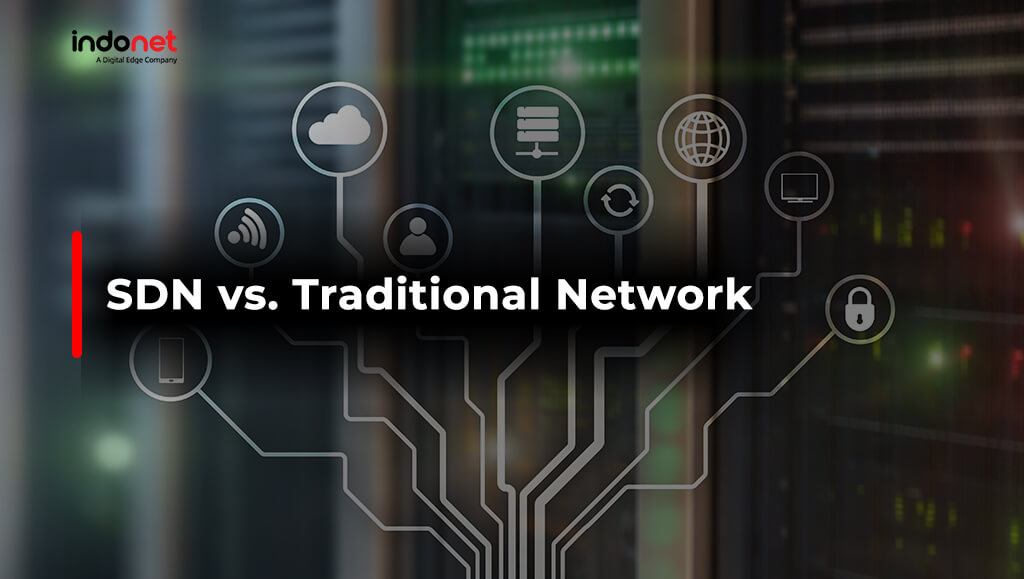The use of the internet to develop business has now become very massive. That way, keeping the internet network running smoothly is very important. To make this happen, you can use a software defined network or traditional network.
However, do you know the difference between SDN and traditional networks?
You need to know that SDN and traditional networks have their own differences and advantages. This time we will discuss what SDN is, traditional networks, and the differences between the two. So you can choose the one that best suits your business needs.
What is SDN or Software Defined Network?
Before discussing the differences between SDN and traditional networks, let’s discuss the definitions of each one. Software defined network itself is a form of very rapid IT development. In simple terms, SDN is a system that helps you design, build, and manage computer networks by separating the control plane and the data plane.
The control plane is responsible for controlling the transfer process or the way data packets are sent from one place to another. Meanwhile, the data plane is useful for carrying or sending actual data packets. Therefore the data plane is also often referred to as the forwarding plane.
Through software defined networks, you can create and control virtual networks or hardware using software. You need to know that SDN uses a software or API-based network controller. This device will be used to communicate with the hardware infrastructure.
Apart from that, this software or API is also useful for directing traffic on the internet network. With this device, you can more easily control internet network traffic. SDN itself is often used for companies that require global or centralized network control processes.
What Is Traditional Network?
After understanding what a software defined network or SDN is, now we will discuss traditional networks. Please note that this traditional network has been around for several decades.
Some examples of traditional networks that we may often encounter include LAN, WAN, WLAN, and Internet Edge. You can find networks like this on computers, servers and various other devices connected to cable infrastructure.
Apart from using cables, traditional networks usually also use devices such as routers and switches to control the network. These two devices are useful for working together and supporting a smooth network. One of the weaknesses of traditional networks is that they are difficult to modify or inflexible.
So this off-the-shelf software cannot be modified to suit hardware-centric networking requirements. So the use of this device can be said to be quite limited. This is what ultimately causes many traditional network users to switch to more flexible software defined networks.
The main function of traditional networks is to enable the transmission of network data between directly connected devices. Examples of devices that are connected directly include computers in offices or data centers.
Difference between SDN and Traditional Network
Did you know, currently many business people prefer to use SDN rather than traditional networks. Apart from more sophisticated technology, SDN is also considered to be able to reduce costs. To answer your curiosity, here are 5 differences between SDN and traditional networks.
-
Differences in IT Infrastructure
The first difference lies in the IT infrastructure, where traditional networks have more complicated infrastructure than SDN. This includes construction, maintenance processes, and provision of equipment. Apart from that, if you use a traditional network, you need professional IT services.
Without professional IT services, you will have difficulty maintaining internet network traffic. Meanwhile, by using SDN, the network administrator’s task will become easier. This is because the infrastructure in SDN can be controlled centrally.
-
Support on Cloud Computing
The next difference lies in cloud computing capabilities. Traditional networks based on conventional routers will find it difficult to implement cloud computing. So if you want to use the cloud you need to completely overhaul all network traffic. This overhaul includes branch offices to hub data centers.
Meanwhile, SDB can be easier and supports the implementation of cloud computing. Through SDN, new lines can be added easily and quickly to sites that need more capacity. So this can reduce the possibility of obstacles or delays that usually occur on the network.
-
Flexibility and Implementation on Networks
What is also a prominent difference between SDN and traditional networks is the flexibility and ease of implementation on the network. As has been said, traditional networks require hardware to control the network. This will make it difficult for you to control the network.
On the other hand, SDN has the concept of programmability and automation, which can make it easier for you to control the network. This concept can change network behavior and these changes can occur automatically. So that changes are more flexible and implementation on the network, such as troubleshooting, will be easier.
-
Differences in Performance and Productivity
Maintaining performance and productivity is something you must pay attention to. By using SDN you can prevent damaged application performance due to limited bandwidth capacity. SDN enables companies to have key applications that can connect to various links, including internal lines and internet connections.
This certainly really helps you to improve performance and productivity via the internet network. On the other hand, traditional networks are known to have limited bandwidth capacity. So this will cause application performance to decrease and create a bird’s eye experience for users.
-
Expenditure Cost Differences
The final difference lies in the amount of costs that must be incurred when using SDN or traditional networks. As has been said, to manage traditional networks you need professional IT services. Of course this will make the company’s expenses greater.
Meanwhile, by using SDN, company expenses can be minimized. This is because cloud-based device management can be done centrally and simply. So you don’t need additional professional IT services to manage internet network traffic.
From the explanation above, it can be concluded that companies can be more productive if they use software defined networks. Not only will performance increase, but you can also reduce company expenses.
After knowing the difference between SDN and traditional networks, now you don’t need to hesitate anymore to use SDN. You can choose Cloud Exchange for digital infrastructure solutions that can effectively help your company achieve digital transformation.
Contact Indonet immediately to get a high-performance connectivity platform and develop your business to the maximum right now!

